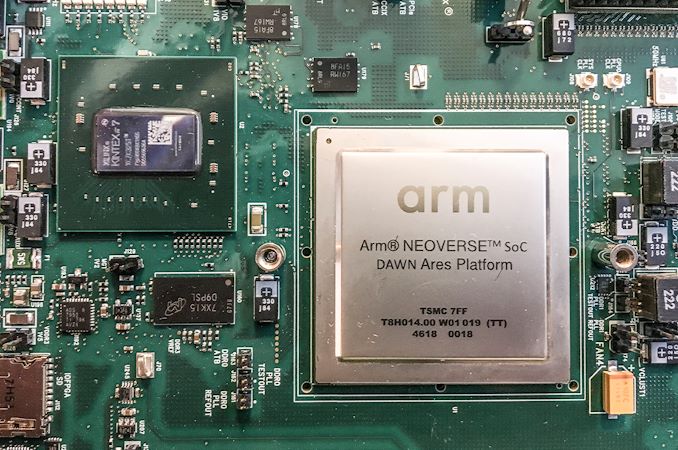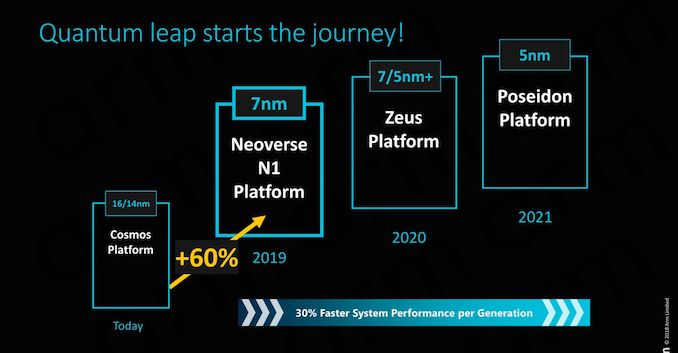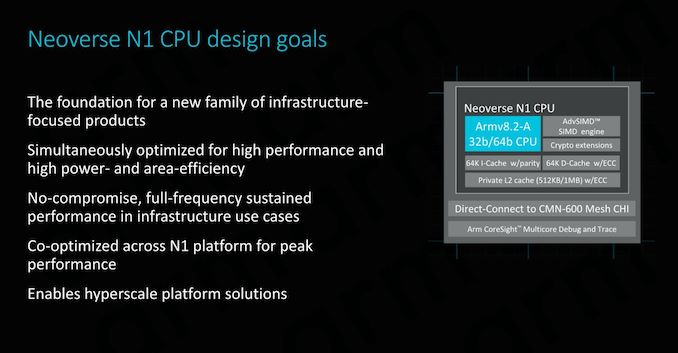AWS Designing a 32-Core Arm Neoverse N1 CPU for Cloud Servers
by Anton Shilov on December 2, 2019 1:00 PM EST
Amazon Web Services’s CPU design unit is working on a new multi-core processor for AWS servers. The new CPU is said to use Arm’s new Neoverse N1 architecture and would feature a considerably higher core-count when compared to AWS’s first-generation Graviton processor, which should result in a significant performance increase.
The yet-to-be-named AWS CPU will be based on Arm’s Neoverse N1 microarchitecture and will integrate as many as 32 cores, according to Reuters, which cites two sources with knowledge of the matter. The chip will also be able to connect to various special-purpose accelerators using a ‘fabric’ interface to greatly speed up certain workloads.
On a high level, the Neoverse N1 (aka Ares) to a large degree resembles Arm’s consumer-oriented Cortex-A76 microarchitecture: a 4-wide fetch/decode machine with a pipeline depth of only 11 stages that can reduce itself to 9 when needed. Meanwhile, the Neoverse N1 is designed to run at relatively high frequencies to provide maximum single-thread performance, it has a different cache architecture (coherent, with 1 MB L2 option, yet caches are technically not a part of the microarchitecture per se), and some other enhancements. Overall, with the Neoverse N1 Arm is looking at clocks of up to 3.1 GHz and a ~100 W TDP per SoC.
Readers who are interested to find out more about Arm’s Neoverse N1 platform can read our coverage from earlier this year, but the key thing in the context of the newly released information is that AWS continues to believe in custom Arm-based processors for servers and would be among the first adopters of the Neoverse N1. As noted above, the microarchitecture and the platform were optimized for cloud server workloads from the ground up, so with with further customization from Amazon, the 32-core processor promises to offer rather serious performance in applications that it was designed for. Will these CPUs challenge AMD’s Rome or Intel’s Cascade Lake? Probably not, but the importance of custom chips is their ability to offer the right total cost of ownership and sufficient performance, not win all the benchmarks.
Related Reading:
- Arm Announces Neoverse N1 & E1 Platforms & CPUs: Enabling A Huge Jump In Infrastructure Performance
- GIGABYTE's Cavium ThunderX2 Systems: 1U R181-T90 and 2U R281-T91
- Assessing Cavium's ThunderX2: The Arm Server Dream Realized At Last
- GIGABYTE's ThunderXStation with Dual Cavium ThunderX2 Arm SoCs
- Investigating Cavium's ThunderX: The First Arm Server SoC With Ambition
- Marvell Completes Acquisition of Cavium, Gets CPU, Networking & Security Assets
- Amazon AWS Offers Another AMD EPYC-Powered Instance: T3a
- Amazon Offers More EPYC: M5ad & R5ad Instances
Source: Reuters












12 Comments
View All Comments
extide - Monday, December 2, 2019 - link
As Anand has said, "There are no bad products, only bad prices" and with Rome able to provide twice the cores in ~twice the TDP all while being at a similar or higher frequency and probably higher IPC .. well, the price will have to be right.Drivebyguy - Thursday, January 2, 2020 - link
Of course Amazon won't sell these chips. They pay the Fab their margin but the rest goes into their own pocket. So AWS can afford to sell cycles on these boxes for cheap and make more money on them than they would on AMD or Intel based servers. And they offer lots of services where they can shift the costs around and not worry about general performance on arbitrary workloads.. If these could handle most of the load of S3 service or RDS or similar, even that is a potentially huge savings.Note that these instances for ec2 are available now for evaluation.
webdoctors - Monday, December 2, 2019 - link
"Will these CPUs challenge AMD’s Rome or Intel’s Cascade Lake"You should probably say performance at the end. As perf/price they might. If AWS is responsible for half the CPUs in use in the datacenter, than this CPU could have more volume than either Intel or AMD's server chips. AWS is getting so big, along with Azure and Google and FB, these data center companies might end up being bigger than the famous brands.
Kind of like how Costco is one of the biggest pizza retailers as a side effect of their store size.
GreenReaper - Monday, December 2, 2019 - link
The trouble is that the high-end tends to also be high-margin. Intel (and now, AMD?) can afford to make essentially no profit - or a loss - on the low-end in order to lock out the competition at that level.Death666Angel - Monday, December 2, 2019 - link
There is such a thing as predatory pricing.mildewman - Monday, December 2, 2019 - link
Its sad that people are still misusing the term "quantum",35 years after the QL.mildewman - Monday, December 2, 2019 - link
From a definition - "In fact, a quantum leap is amazingly small. The word quantum refers to the smallest amount of something that you can have."jwittich - Tuesday, December 3, 2019 - link
Technically, its referring to quantum states and not strictly a quantized amount. Moving from one discrete state to another in a very rapid fashion would qualify as being similar to a "Quantum Leap", which does capture what people usually mean. Its the rate of change the more accurately conveys the sense vs the distance of the change.ksec - Tuesday, December 3, 2019 - link
I will be surprised if they even have 70% of Skylake performance. A High Clock speed A76 simply wont do it.Much more looking forward to Zen 3 EPYC.
Wilco1 - Tuesday, December 3, 2019 - link
Neoverse N1 is about 45% faster per vCPU according to this: https://zdnet1.cbsistatic.com/hub/i/2019/11/30/3d9...So assuming Hyperthreading gives 30%, per-core performance is 95% of Skylake-SP.